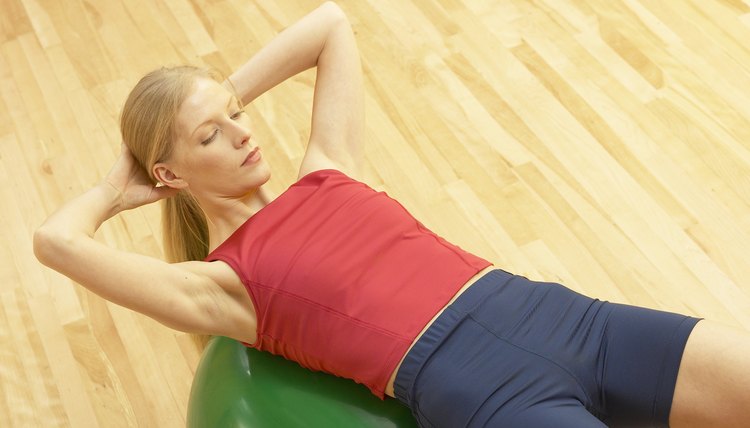What Muscles Are Being Used in Stability Ball Crunches?

In stability ball crunches, you position your back over a stability ball, with your knees bent and feet on the floor. Then, you peel your upper back off the ball, decreasing the distance between your ribs and hips. Once your shoulder blades come off the ball, you slowly roll your spine back to the starting position. This exercise works a variety of muscles throughout the body.
Primary Muscles
Stability ball crunches primarily target the abdominal muscles. They strengthen the rectus abdominis, the long sheets of muscle that lie just under the skin and are responsible for the six-pack look. They also target the transversus abdominis, an abdominal muscle essential to maintaining good posture. Finally, stability ball crunches work the obliques, abdominal muscles that help with twisting and bending movements.
Secondary Muscles
When performing crunches on a stability ball, you use several other muscles to stabilize your body and help the primary muscles perform their actions. These muscles include the erector spinae in the back, the posterior deltoids and rhomboids in the shoulder, and the gluteus minimus, gluteus medius and adductors in the hips and thighs.
Positioning the Ball
According to research published in "Journal of Strength and Conditioning Research," the placement of the ball can affect stability ball crunches. When the ball is positioned under the lower back, the abdominal muscles work twice as hard as when the ball is positioned at the level of the shoulder blades. Advanced exercisers should position the ball lower on the back, while beginners can position the ball higher up the back.
Differences Between Floor Crunches
Unlike a floor, stability balls are unstable surfaces. Working against this instability requires coordination and balance. In a study published in "Journal of Ergonomics," researchers investigated the effectiveness of different types of abdominal exercises. They found that when compared with floor crunches, stability ball crunches more effectively recruit the upper and lower fibers of the rectus abdominis as well as the external obliques.
References
- American Council on Exercise: Stability Ball Sit-ups/Crunches
- American Council on Exercise: Stability Ball Workout
- Journal of Ergonomics: Electromyographic Investigation of Abdominal Exercises and the Effects of Fatigue
- Journal of Strength and Conditioning Research: Electromyographic Comparison of a Stability Ball Crunch With a Traditional Crunch
Writer Bio
Kat Black is a professional writer currently completing her doctorate in musicology/ She has won several prestigious awards for her research, and has had extensive training in classical music and dance.
